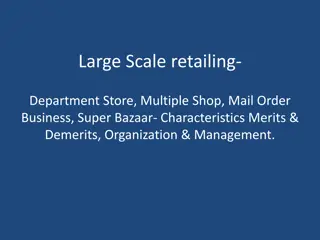Dollar Store Dominance and Community Impact
Discover how Dollar General and Dollar Tree are leading the retail sector with their vast store presence and strategic growth plans. Explore the implications of dollar stores on communities and the shifting landscape of grocery options.
Download Presentation

Please find below an Image/Link to download the presentation.
The content on the website is provided AS IS for your information and personal use only. It may not be sold, licensed, or shared on other websites without obtaining consent from the author.If you encounter any issues during the download, it is possible that the publisher has removed the file from their server.
You are allowed to download the files provided on this website for personal or commercial use, subject to the condition that they are used lawfully. All files are the property of their respective owners.
The content on the website is provided AS IS for your information and personal use only. It may not be sold, licensed, or shared on other websites without obtaining consent from the author.
E N D
Presentation Transcript
More Stores Than Any Other Sector or Brand $ According to a June 2019 report from Quantum Real Estate Advisors, 2018 revenues for the dollar & variety store category totaled $77 billion. Dollar General, Dollar Tree and Family Dollar, which Dollar Tree acquired during 2015, control 75% of the market. $ Since 2000, an additional 11,249 dollar stores have opened, with convenience stores second at 8,650, while 638 department stores, 865 office supplies, 1,066 bookstores, 4,125 apparel stores and 6,425 consumer electronics stores closed. $ The number of Dollar General stores (15,200) and Dollar Tree/Family Dollar stores (14,600) total more than Starbucks (14,600) and McDonalds (14,00) combined.
Just a Two-Behemoth Battle $ Some significant investors in Dollar Tree are recommending it eliminate or sell the Family Dollar chain because of its underperformance. Dollar Tree is responding with the closure of 390 Family Dollar stores and converting 200 to the Dollar Tree brand. $ While Dollar Tree adjusts its business model, Dollar General continues its domination with a much-improved Q1 2019 fiscal report, including an 8.3% increase in net sales, or a total of $6.6 billion, and a 3.8% increase in same-store sales. $ Dollar Tree had a good Q1 2019 fiscal quarter too, with net sales increasing 4.6% to $5.8 billion and same store sales increasing 2.2%. Family Dollar s comps increased 1.9%, compared to 2.5% for Dollar Tree.
Merchandise Diversification Fuels Future Growth $ Offering more and fresher grocery items is the active strategy for Dollar General and Dollar Tree. During 2018, the two chains, combined, sold $24 billion in groceries compared to approximately $15 billion at Whole Foods Market. $ Dollar General s DG Fresh concept now has 4 distribution centers for the self-distribution to 3,500 of its stores by the end of 2019. It is also expanding its inventory with higher-priced, but competitive, home and party items to attract more affluent consumers. $ Dollar Tree has added more adult beverages and space for frozen and refrigerated items to its flagship stores while adding more freezer capacity to the Family Dollar stores it is remodeling and rebranding.
Not in My Community! $ As dollar stores proliferate in urban and rural areas with either predominately African American or low-income households, or both, grocery stores and their fresher food have disappeared from many of these communities. $ As the number of food deserts increase, many communities, such as Tulsa, OK, are becoming proactive. A new city councilperson there persuaded the council to limit the number of dollar stores on Tulsa s north side and promote more full-service food stores. $ Although dollar stores were welcomed in these communities initially, as they were often the first commercial investment for years, the stores employ fewer people and the closing of the grocery stores they replace have a substantial negative impact.
A Closer Look at Dollar General $ According to data from Numerator s Retailer Snapshot, which captures 1 of every 500 shopping trips, the purchase cycle at Dollar General is 57.4 days, the average basket contains 6.5 items and the average basket costs $16.83. $ Adults 45 54 and 55 64 have the highest indices of Dollar General shoppers by age, or 115 and 114, respectively. African Americans have the highest index by ethnicity, or 143, with Caucasian Americans, 110; Latinx Americans, 63; and Asian Americans, 19. $ Unsurprisingly, the three lowest household income brackets also score the highest indices, or less than $20K, 167; $20K $40K, 145; and $40K $60K, 112. By comparison, households with incomes of more than $125K have an index of 40.
A Closer Look at Dollar Tree $ Dollar Tree s shopping data is quite similar to Dollar General s, or a purchase cycle of 55.9 days, an average basket size of 8.1 items and an average basket cost of $12.14. $ Demographically, adults younger than 24 score the highest index, or 115, with those 45 54 and 55 64 with indices of 101 and 104, respectively. African Americans index is 221, and Latinx Americans, 125. $ Dollar Tree s demographic profile certainly suggests customers with less education. The Numerator data indicates those with no college have an index of 130, compared to 98 for those with a college degree and 75 for those with an advanced degree.
Advertising Strategies $ To compete with the two giants, Dollar General and Dollar Tree, smaller chains as well as local stores must follow their lead and introduce more grocery items and fresh food items, specifically, and possibly outcompete them with a few items they don t offer. $ Another group of merchandise smaller chains and local stores must add is home and party items not only to divert some of this discretionary spending from grocery and big-box stores, but also to attract more affluent customers with higher quality merchandise. $ Share the information on page 3 of the Profiler from Numerator s Retail Snapshot of Dollar General and Dollar Tree with smaller chains and local stores against which they can measure their performance in these categories.
New Media Strategies $ If dollar stores receive community backlash about their proliferation and other negative perceptions, then they can use social media to post content, especially videos, of how they are contributing to the local community, including interviews with employees. $ Store operators can use the four type of shopping trips in the first table on page 3 of the Profiler as topics for social media content, explaining each, and possibly posting short videos of where the items related to those types are located in the store. $ Information about social services and other community programs is another type of content dollar stores can post on social media to project a positive image for the local community. They can also incentivize their employees to participate in community projects.























